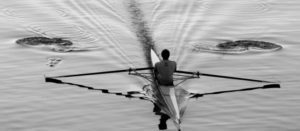A guest post by Dan McNair – Rowperfect ‘met’ Dan on twitter and he kindly agreed to write us a guest article on coaching communication skills.
Have you ever told a small child “don’t jump on the bed”, or “don’t hit your sister” or “don’t…(fill in the blank with whatever undesired behavior fits the moment)”, only to have them do EXACTLY what you just told them not to?
It’s not that kids are prone to deviant behavior, rather it’s a flaw in the communication. It’s actually very human for the brain to gloss over the “don’t” part of the command and focus more on the bed-jumping or sister-hitting, hence the outcome.
The same is also true with rowers, frustrating a great many coaches.
Rowers don’t listen
I’ve ridden in a lot of launches with other coaches and listened as they lament about that one flaw they can’t seem to fix about a particular rower. “I tell him every day not to slouch”, or “…not to dip his hands at the catch”, or “…not to rush her slide”, etc.
You can almost hear the rower’s brain saying, “Ok I get it, but what do you want me to do instead!?!”
Telling your rowers they are making a mistake is a good start; at least it is some feedback, but it’s only half the battle.
Help them identify a solution, not just the problem.
So how do I coach ‘solutions’?
Try these commands instead.
“Three seat, sit tall and try hold to your core stable.”
“Seven seat, keep your hands level coming into the catch, and just allow the handle to rise slightly at the front end.”
“Two seat, slow your seat down. Keep the wheels steady and relax.”
It may seem too simple at first, but removing the “not” and framing your command in the positive can have a profound effect.
Business leaders also use this little “secret” because they know you get more of what you focus on (like tracking and reporting injury-free work days instead of accidents).
How to get athletes to do it
1. Stop telling your athletes what not to do and tell them what you DO want instead.
This works especially well with novices who are less likely to interpret negative feedback and instinctively know how to make the fix, but it’s effective at all levels.
2. Describe the desired outcome rather than just the flaw and watch the athletes respond. I bet you get more of what you focus on and I’d love to hear about your results.
Dan McNair @coachdanmcnair
Dan is an HR Consultant and trainer to business leaders on areas such as communication and performance management through coaching; he has been rowing or coaching in the US since 1992
Add your feedback on Dan’s methods in the comments below.







